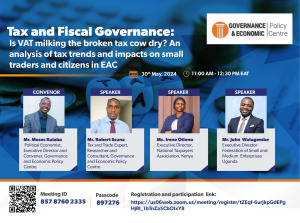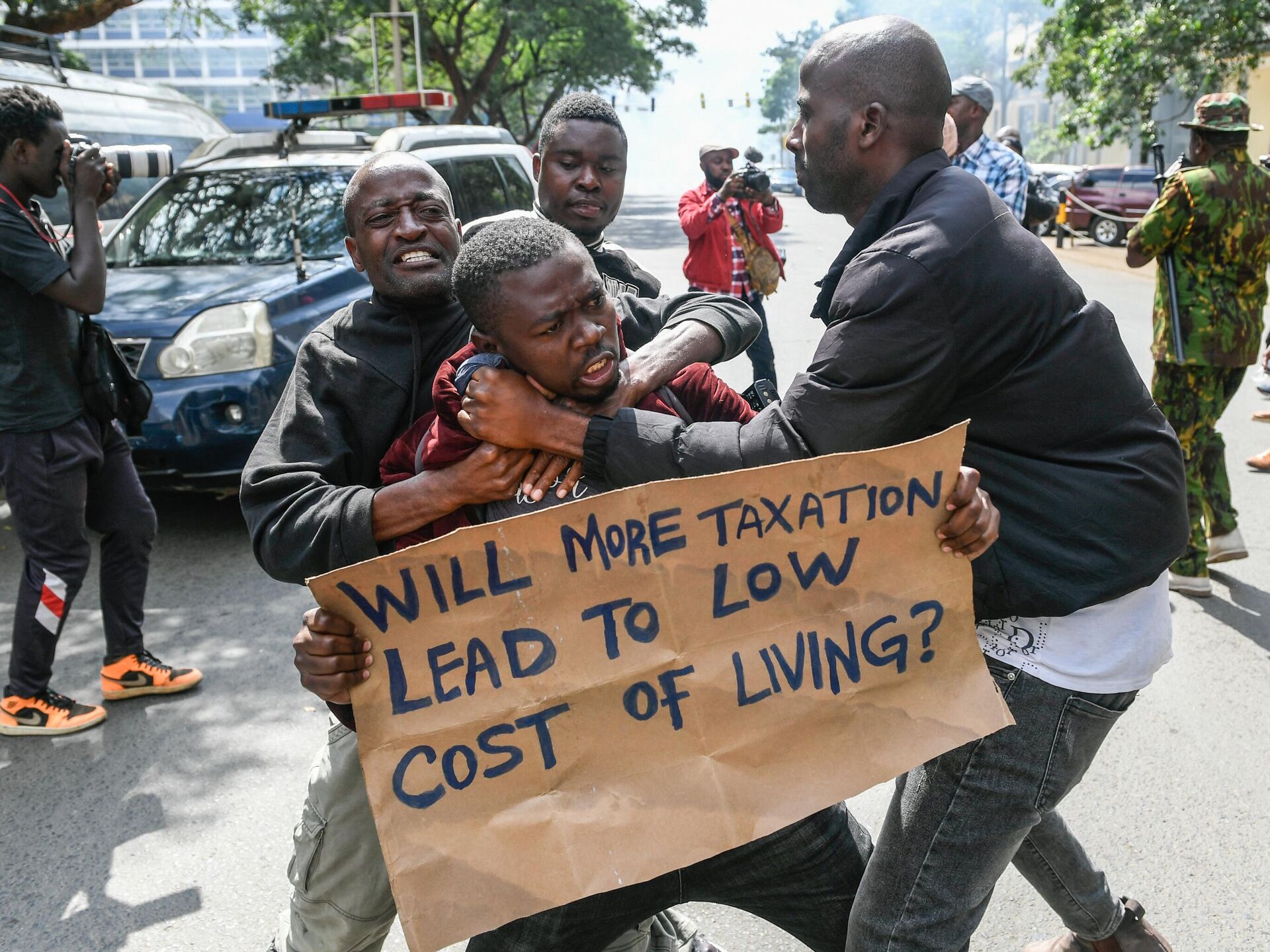Tax and Fiscal Governance: Is VAT milking the broken tax cow dry? An analysis of tax trends and impacts on EAC small traders and citizens, with a case of the recent traders’ boycotts in Uganda
With dwindling foreign aid, it appears the governments in East Africa have resorted to squeezing everywhere to raise some dime. Taxation may be good however, when the extremes are beyond reasonableness, countries are bound to break the back of the economies they aspire to build. Could the recent demonstrations in Kampala show a mismatch of tax policy and that the tax cow may be now broken or is it a case of misunderstanding of the tax system and the dividends of taxation?
By Robert Ssuuna, Researcher, Trainer, and Consultant,
Governance and Economic Policy Centre
@ Tax policy @ Tax justice @africataxproffessionals @fiscalgovernance

People go about their everyday business in Kikuubo, one of Kampala’s busiest trading areas.
Recently media in Uganda has been inundated by the stand-off between the Government and traders in the Central Business District of Kampala’s Capital Uganda locally known as Kikuubo with traders choosing to close shops in protest. The protest which later spread to other cities like Jinja, Mityana, and Masaka was triggered by the implementation of the Electronic Fiscal Receipt and Invoicing System (EFRIS) by the Uganda Revenue Authority.
According to the Taxman, the solution is intended to address concerns related to Value Added Tax (VAT) fraud. VAT is known as an indirect tax charged by businesses at each stage of the production and distribution chain up to the retail stage of goods and services. VAT was introduced in 1996 replacing the sales tax and has since proved a reliable source of revenue contributing 30% of Total Tax Revenues on average and 4.4% of GDP[1]. To understand how well the VAT regime is managed in the country we use two main metrics, these are;-
- VAT productivity which is the VAT revenue yield to GDP divided by the nominal VAT tax rate. VAT productivity measures how much each percentage point of the standard VAT rate collects in terms of GDP as given by the following ratio.
- VAT Productivity= VAT Revenue/ GDP (Standard VAT rate)
- VAT C-Efficiency which measures the VAT revenue performance and overall efficiency of the VAT system in an economy. The efficiency ratio is given by VAT revenue yield to the approximated proxy (Final Consumption) divided by the VAT tax rat It follows that, if VAT compliance was perfect, actual revenue over potential revenue, would be one. C-efficiency ratio is given as:-
- VAT-C Efficiency = Actual VAT revenue/(Final Consumption)(Standard VAT Rate)
Where actual VAT Revenue implies Total VAT collections less VAT refunds.
Using the above indicators, we establish that in 2023 Uganda registered VAT productivity of 22% while the VAT C-efficiency ratio stood at 21% way below the African averages of 27.6% and 37.8% respectively (ATO, 2023)
Lower VAT productivity and C-Efficiency ratios imply a higher difference between real and declared revenues and consequently few economic agents meet their VAT obligations.
From the simple results indicated above, one might argue that the Government is justified to institute both policy and administrative mechanisms to address the low VAT productivity and VAT C- efficiency. One such intervention is the introduction of the EFRIS.
The system manages business transactions, tracks stock movements, automatically applies VAT-inclusive taxes (which directly affect informal traders’ profits), issues precise and traceable invoices, and promptly reports sales data to the revenue authority in real time. Through automated cross-checks the URA can more effectively match buyer and seller invoices, thereby preventing taxpayers from claiming input VAT credits without corresponding reports from sellers. Theoretically, this system tackles tax evasion in two main ways: Firstly, by creating a more accurate digital trail, it enhances URA’s monitoring capabilities and raises the likelihood of detecting evasion. Secondly, by offering clearer transaction records and facilitating pre-filled tax returns, it encourages voluntary compliance by simplifying the tax filing process. So one wonders why traders and the Government fail to agree on such a solution given the associated benefits.
From the informal trader’s perspective, EFRIS exposes them to the risk of “premature formalization,” where their tax compliance costs, including penalties for non-compliance, escalate faster than any benefits gained from their efforts to sustain themselves. Traders believe that any measure that decreases the amount of money they have to spend freely is essentially a tax.
The challenges posed by the EFRIS system stem from concerns about reduced incomes caused by lower sales due to increased prices resulting from VAT on purchases made by informal sector operators, particularly Kikubo Traders, from formal sector operators. Additionally, there’s a decrease in income from their imports. These worries are intensified by URA’s strict enforcement tactics and the looming possibility of facing full taxation scrutiny from tax authorities. Critical issues associated with EFRIS are:-
First, is the general lack of awareness among the trading community on what EFRIS is, its objectives, benefits, and associated challenges despite URA’s investment in taxpayer education since 2021 when the solution was rolled out. It is no surprise that some traders regard this as another tax. Some of the traders also clearly seem not aware of how the VAT mechanism operates especially the Input versus output approach.
The second factor is the mode of implementation and per-requisites for the EFRIS. Traders are worried about the costs associated with EFRIS. These include among others, hiring accountants or at least personnel with electronic numerical literacy, purchase of software, internet, purchase of the EFRIS gadgets, etc. Although all these are allowable expenses under the Income Tax Act, in the medium term they eat into traders’ working capital. To curtail these, the EFRIS regulations prescribe penalties for non-issuance of receipts generated by EFRIS and nonuse of EFRIS gadgets. The penalties are from UGX 6,000,000 and UGX 8,000,000 respectively ( USD1700&USD 2200).
Third, is the VAT threshold. Currently, EFRIS is a requirement for only VAT-registered taxpayers with annual gross sales of UGX 150,000,000 (USD 42000). The initial registration threshold was set at shs.20 million, and then increased to shs.50 million in November 1996, following a strike by traders. The threshold was further increased to shs.150 million in 2015, and it was argued, that including small businesses in the tax net by setting a very low VAT registration threshold can drain the limited resources available to the tax authority for administration, and yet the revenue potential is insignificant because of the low turnover and low-value addition. This is because VAT tends to impose high compliance costs on small informal traders who generally do not have sufficient resources to keep proper records of their transactions and comply with accounting rules.
With the depreciation of the UGX against the dollar since 2015, traders argue that the VAT registration threshold should be increased at least to UGX 1Bn to reflect current economic trends. Traders are also concerned that non-VAT qualifying suppliers are being denied by large supermarkets and departmental stores if they do not prove adherence to EFRIS requirements. This locks small-scale traders out of the supply chain affecting their earnings.
Finally, we note that traders are using the demonstration on EFRIS to buttress other perennial issues affecting their operations and contributing to taxpayer apathy. These include unclear application of import duties and valuation for used clothing (a blend of advalorem and specific duties), protracted VAT refund processes, general poor public service delivery, and glaring corruption scandals by politically exposed persons.
It must however be noted that the issue of VAT has been a concern of small traders across the East African Member states. The recent Ugandan demonstrations perhaps are a manifestation of the weaknesses and challenges of Tax policy and administration across the region.VAT is generally considered a regressive tax and one whose implementation has always been a source of concern and perhaps should be evaluated.
VAT protest trends across East Africa

The litany of small traders’ strikes started last year (May 2023) in Tanzania when the traders in Kariakoo, Tanzania’s, and perhaps East, Central, and Southern Africa’s largest commercial hub locked up their shops in protest over what was considered as taxation. Among the multiple taxes and levies protested was VAT. The traders wanted this reduced to 16% among others. This later picked momentum with strikes and protests in Kenya, when the government proposed in its 2023 Finance Bill to increase the VAT, particularly on fuel products from an earlier 8% to 16%. To date, the Kenyan business community is not happy with this increase and has been complaining that a higher VAT increases the costs of living to the citizens, doing business in Kenya and is detrimental to Kenya’s industrialization agenda.
In its 2024 Finance Bill, the Kenyan government has proposed to introduce VAT on bread, which is largely viewed as a staple breakfast food for Kenyans. If the proposal sails through parliament, bread, which is currently on a list of items that are zero-rated for VAT purposes— including flour, milk, and sanitary products— will attract the 16 percent tax that will see the commodity increase by at least Sh10 for 400-gram loaf. The government argues that levying bread with VAT is necessary because its zero rating was misplaced since it benefits the middle class who shop in supermarkets rather than the targeted low-income households.
Kenyans are generally not happy with this and if it is passed there could be another round of protests from different sections of what is already considered an ‘over-taxed’ Kenyan taxpayer.
Therefore the following measures should be taken to ensure that the Governments continue to milk the cow without breaking it,
- Invest in Taxpayer education and awareness should be a continuous process
- Improve accountability for the use of taxpayer money by improving the quality of public services and apprehending the corrupt to encourage voluntary compliance.
- Improve tax administrative efficiencies by continuously equipping URA staff with skills and ensuring that the staff numbers are adequate to manage the tax register.
- When introducing new systems such as EFRIS, tax administration should invest in reasonably wider consultation and ensure the participation of all those likely to be affected by the system from the design stage.
- Invest in agricultural commercialization, productivity, and industrialization to ensure that the majority of the agricultural sector actors are within the money economy to broaden the tax base.
- The government must develop a proper Tax policy to guide taxation and predictability of tax administration
Forthcoming Expert Webinar on Taxation and Tax Policy in East Africa
To discuss and dissect this further we have organised an expert webinar on this subject will be coming up on the 30th May, 2024. Please register to attend via the links below:

Title: Tax and Fiscal Governance: Is VAT milking the broken tax cow dry? An analysis of tax trends and impacts on small traders and citizens in EAC
Date: 30th May, 2024
[1] Author computation based on Revenue Statistics from the URA

